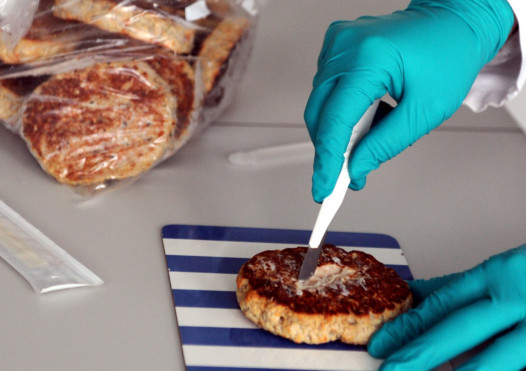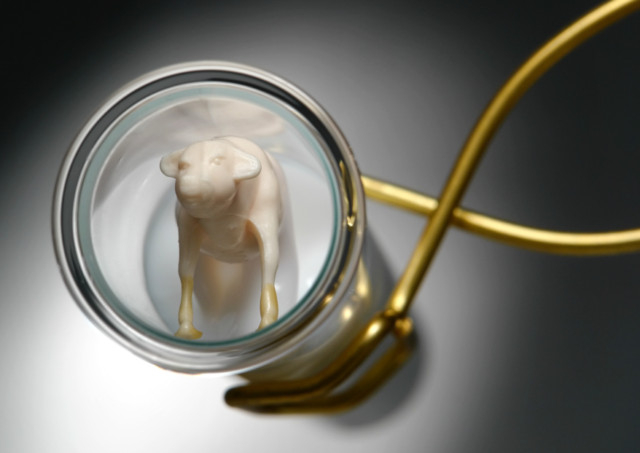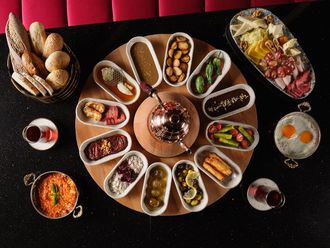
The future of the food industry rests in a Petri dish in a laboratory without a slaughtered animal in sight. As scientists come close to creating edible lab meat (or in vitro meat), the food industry reaches a crossroads and every stakeholder wants a say in the direction it takes.
It’s well-known that the volume of meat being devoured worldwide is unsustainable. Some 150 billion animals are reared for their meat every year, according to some estimates. And with the global demand for meat expected to grow by up to 60 per cent by 2050, something drastic needs to be done if a projected population of more than nine billion is still to be eating steak halfway through the 21st century. Cue thunder, lightning and a mad professor working diligently in a secluded laboratory, huddled over translucent test tubes with animal stem cells and an idea that could change the world.
Prof. Mark Post, a physiologist at Maastricht University in the Netherlands, is the precursor of a handful of scientists pushing the agenda for in vitro meat, which he says could reduce the environmental footprint of meat eaters and suppliers by up to 60 per cent.
In vitro meat, which also goes by the nickname “shmeat”, is animal tissue cultivated from myoblasts (embryonic progenitor cells), taken from animals via biopsy. These cells are mixed with the requisite proteins and fatty acids and grown under lab-monitored conditions, while the donating animal lives on.
This method requires 1 per cent of the land, 2 per cent of the water and promises a 90 per cent reduction in greenhouse gases used by traditional meat production methods. Furthermore, it obviates trillions of kilos of unused animal waste. These facts score high with animal rights activists, but are bad news for farmers.
Looking ahead, the issue of how halal protocol would feature in these science-led plans for the future of meat needs to be addressed for a culture that consumes a large share of the industry. According to estimates by the Economist Intelligence Unit, total food imports into the Gulf, which must be halal, are set to double from $25 billion (Dh91.79 billion) in 2010 to $53 billion in 2020.
Dr Abdul Qahir Qamar, Director of Fatwa and Sharia rulings at the International Islamic Fiqh Academy, an affiliate of the Organisation of the Islamic Conference based in Saudi Arabia, tells GN Focus: “If scientists produce in vitro meat in the laboratory, it will not be considered meat from live animals, but will be cultured meat.”
Because the animal is not slaughtered, its life is vegetative and “similar to yogurt and fermented pickles”. In order for in vitro meat to be classified halal, Dr Qamar says, “The myoblasts must be taken from animals considered halal; products from pigs, dogs or wild animals with fangs or any other animals considered haram [unlawful] in Islamic law should not be used in any stage of the production process and neither should substances such as blood; and such products should not be detrimental or cause any harm to humans or the environment in any way.”
AbdulHamid Evans, Founder of HalalFocus, an online daily halal analytical news publication, says an area of contention could arise if the concept were to be considered under Islamic law.
“The majority of Sharia-compliant policies are not sufficiently educated in technological issues to really make an informed decision, as seen with GMO [genetically modified organism] issues where it wasn’t the process that was ever examined, just the original organism. So we’ve only ever seen quite simplistic judgements [on food technology].”
Given the backdrop of the recent halal scandals in the UK, the need to implement clearly demarcated regulations is of paramount importance if the fault lines between religion and science are not to be exacerbated any further.
Outside the Muslim world, advocates of the Dutch scientist’s burgerlicious brainchild have to contend with the social and cultural questions it throws up as well as with the yuck factor.
Daniel During, Managing Director, Thomas Klein International, a Dubai-based restaurant consultancy, says the practice raises some far-reaching philosophical issues.
“It raises the issue that it’s unethical to grow [billions of] animals to be killed for food, but I would ask, ‘Is it ethical to emulate God and create meat?’
“We have been born hunters and carnivores and we remain as such, so is it unethical to not be what we have been created as?”
Consumers and restaurateurs still feel a deep affinity with authentic meat and are reluctant to look past the scary science label.
Aztaj Eddoukani, Executive Chef, Anantara Eastern Mangroves Hotel, says he would “never” serve lab meat to his customers. “I would never even buy it for myself at home, so if I don’t consume it then why should I serve it to my guests?
“I want my guests to eat meat that is tender with wonderful texture and taste. I don’t see the point in using [lab] meat just because it’s cheaper. I would prefer to stick to authentic methods of meat production and consumption. There is no pride in having cheap lab-produced meat.”
While the research costs of the first lab burger are not cheap — Prof. Post’s budget was reportedly in excess of $300,000 — stem cells acquired from one animal have the potential to feed billions of people, which will drive down the cost of meat in the long run.
But Eddoukani’s reaction is indicative of the meat purist. And it’s an attitude science bodies will have to confront. Furthermore, the question of whether the public are prepared to look past the label and buy into the scheme is not easily answered.
During says the final product may be some years away yet. “We don’t yet know what the impact will be on our bodies after consuming such substitute products over extended periods,” he says. “We would therefore probably need to test it over a period of at least ten years before we can be sure the lab-produced protein is safe for human consumption.”















